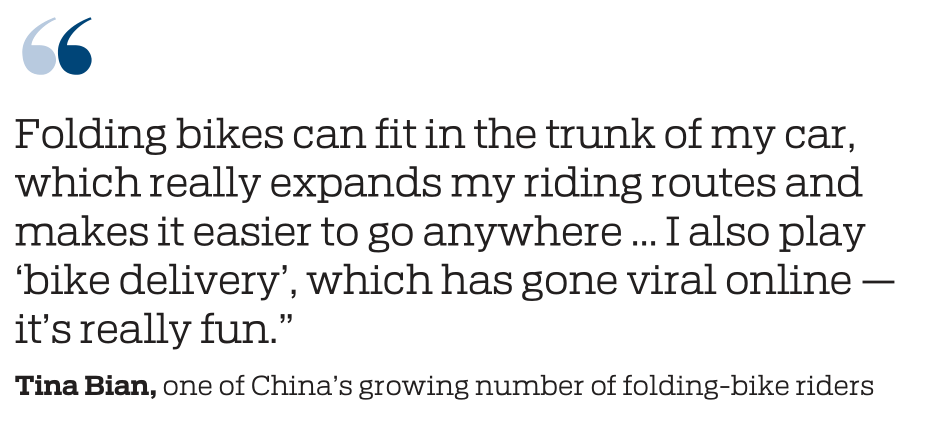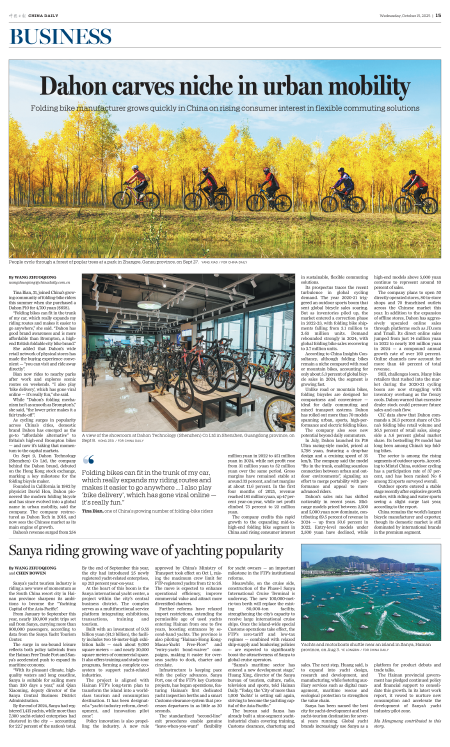
People cycle through a forest of poplar trees at a park in Zhangye, Gansu province, on Sept 27.

A view of the showroom at Dahon Technology (Shenzhen) Co Ltd in Shenzhen, Guangdong province, on Sept 8.

Tina Bian, 31, joined China's growing community of folding-bike riders this summer when she purchased a Dahon P10 for 4,700 yuan ($658).
"Folding bikes can fit in the trunk of my car, which really expands my riding routes and makes it easier to go anywhere," she said. "Dahon has good brand awareness and is more affordable than Brompton, a high-end British foldable city bike brand."
She added that Dahon's wide retail network of physical stores has made the buying experience convenient — "you can visit and ride away directly".
Bian now rides to nearby parks after work and explores scenic routes on weekends. "I also play 'bike delivery', which has gone viral online — it's really fun," she said.
While "Dahon's folding mechanism isn't as smooth as Brompton's," she said, "the lower price makes it a fair trade-off".
As cycling surges in popularity across China's cities, domestic brand Dahon has emerged as the go-to "affordable alternative" to Britain's high-end Brompton bikes — and now it's taking that momentum to the capital markets.
On Sept 9, Dahon Technology (Shenzhen) Co Ltd, the company behind the Dahon brand, debuted on the Hong Kong stock exchange, marking a key milestone for the folding bicycle maker.
Founded in California in 1982 by physicist David Hon, Dahon pioneered the modern folding bicycle and has since evolved into a global name in urban mobility, said the company. The company restructured as Dahon Tech in 2016, and now sees the Chinese market as its main engine of growth.
Dahon's revenue surged from 254 million yuan in 2022 to 451 million yuan in 2024, while net profit rose from 31 million yuan to 52 million yuan over the same period. Gross margins have remained stable at around 33 percent, and net margins at about 11.6 percent. In the first four months of 2025, revenue reached 185 million yuan, up 47 percent year-on-year, while net profit climbed 73 percent to 22 million yuan.
The company credits this rapid growth to the expanding mid-to-high-end folding bike segment in China and rising consumer interest in sustainable, flexible commuting solutions.
Its prospectus traces the recent turbulence in global cycling demand. The year 2020-21 triggered an outdoor sports boom that sent global bicycle sales soaring. But as inventories piled up, the market entered a correction phase in 2022-23, with folding bike shipments falling from 3.1 million to 2.65 million units. Demand rebounded strongly in 2024, with global folding bike sales recovering to 3.7 million units.
According to China Insights Consultancy, although folding bikes remain a niche compared with road or mountain bikes, accounting for only about 5.3 percent of global bicycle sales in 2024, the segment is growing fast.
Unlike road or mountain bikes, folding bicycles are designed for compactness and convenience — ideal for daily commuting and mixed transport systems. Dahon has rolled out more than 70 models spanning urban, sports, high-performance and electric folding bikes.
The company also sees new potential beyond daily commuters.
In July, Dahon launched its P18 Ultra racing-style model, priced at 5,798 yuan, featuring a drop-bar design and a cruising speed of 35 km/h. The company said the model "fits in the trunk, enabling seamless connection between urban and outdoor environments", signaling an effort to merge portability with performance and appeal to more advanced riders.
Dahon's sales mix has shifted noticeably in recent years. Midrange models priced between 2,500 and 5,000 yuan now dominate, contributing 69.5 percent of revenue in 2024 — up from 50.6 percent in 2022. Entry-level models under 2,500 yuan have declined, while high-end models above 5,000 yuan continue to represent around 10 percent of sales.
The company plans to open 50 directly operated stores, 80 in-store shops and 70 franchised outlets across the Chinese market this year. In addition to the expansion of offline stores, Dahon has aggressively upscaled online sales through platforms such as JD.com and Tmall. Its direct online sales jumped from just 14 million yuan in 2022 to nearly 100 million yuan in 2024 — a compound annual growth rate of over 160 percent. Online channels now account for more than 40 percent of total revenue.
Still, challenges loom. Many bike retailers that rushed into the market during the 2020-21 cycling boom are now struggling with inventory overhang as the frenzy cools. Dahon warned that excessive dealer stock could pressure future sales and cash flow.
CIC data show that Dahon commands a 26.3 percent share of China's folding bike retail volume and 36.5 percent of retail sales, alongside a 5.6 percent global market share. Its bestselling P8 model has long been among China's top folding bikes.
The sector is among the rising segments of outdoor sports. According to Mintel China, outdoor cycling has a participation rate of 37 percent, and has been ranked No 6 among 22 sports surveyed overall.
Outdoor sports entered a stable stage recently after explosive growth earlier, with riding and water sports seeing a slight surge last year, according to the report.
China remains the world's largest bicycle manufacturer and exporter, though its domestic market is still dominated by international brands in the premium segment.
wangzhuoqiong@chinadaily.com.cn

